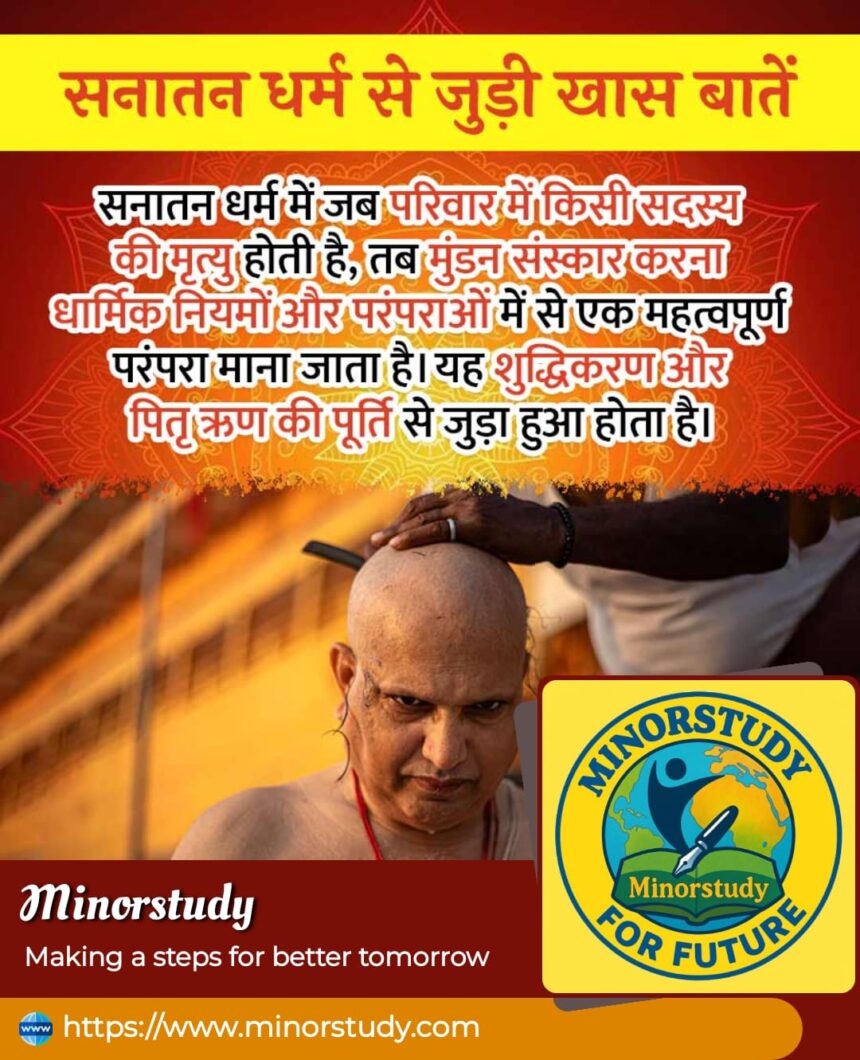9 Spiritually Powerful Truths About Mundan Sanskar After Death in Sanatan Dharma – A Sacred Journey of Purification
Mundan Sanskar: In the timeless and deeply spiritual framework of Sanatan Dharma, every ritual has a purpose that transcends the material. Among the many significant observances, one ritual that often evokes a mixture of reverence and emotional intensity is the Mundan Sanskar (tonsure ceremony) performed after the death of a family member.
- 📜 What Is Mundan Sanskar After Death?
- 📚 Historical and Scriptural Roots
- 📅 Timeline: When is Mundan Sanskar Performed After Death?
- ✅ 9 Spiritually Powerful Truths Behind Mundan Sanskar After Death
- 1. Symbol of Inner Purification
- 2. A Mark of Mourning
- 3. Fulfillment of Pitr Rina
- 4. Letting Go of Material Vanity
- 5. Connecting the Physical and Spiritual Realms
- 6. Uniting with the Universal Cycle
- 7. Equalizer of All Social Status
- 8. Readiness to Perform Shraddha
- 9. Encourages Detachment and Healing
- 🔍 Important Observances & Ritual Steps
- ❓ FAQs About Mundan Sanskar After Death
- Q1: Is Mundan after death compulsory?
- Q2: Can women perform this ritual?
- Q3: Why is it done on the 10th or 11th day?
- Q4: What happens if the ritual is skipped?
- Q5: Is it only a Hindu tradition?
- 🌿 Daily Life and Societal Impact
- 🎉 Sacred Wishing and Blessings
- 📌 Important Points to Remember
- 🧘 Conclusion: An Act of Love, Not Just Ritual
Often misunderstood or regarded as a mere tradition, this sanskar is rich in philosophical depth, spiritual symbolism, and ancestral duty. It is not merely a custom—it is a sacred bridge between generations, a ritual of renunciation, and a step toward emotional and spiritual healing.
In this human-friendly, deeply insightful article of over 1200 words, we’ll explore the history, meaning, facts, timeline, FAQs, and real-life impacts of this sacred tradition.
📜 What Is Mundan Sanskar After Death?
Mundan Sanskar, also known as Keshant Sanskar or Chudakarana, is typically a life-cycle rite (Samskara) performed on infants. However, a special form of Mundan is also observed after the demise of a close relative, especially parents or elders. It involves the shaving of hair—symbolizing detachment, purification, and mourning.
It is practiced mainly by sons or male heirs, though in some traditions and regions, symbolic or modified forms may also apply to others.
📚 Historical and Scriptural Roots
The Vedas, Smritis, and Puranas offer multiple references to Mundan Sanskar being connected to purification rituals, especially in the context of death and Pitr Rina (ancestral debt).
Key texts such as:
Garuda Purana
Manusmriti
Yajnavalkya Smriti
Shraddha Kalpa of Atharva Veda
… all mention the importance of cleansing rituals including shaving, bathing, and donning white clothes after death rituals to mark the transition from grief to spiritual clarity.
📅 Timeline: When is Mundan Sanskar Performed After Death?
| Timeframe | Ritual |
|---|---|
| Day 1-3 | Antyeshti (cremation) and initial mourning |
| Day 10 | Dasah – purification and ritual bath |
| Day 11-12 | Mundan (shaving of the head by sons) often takes place here |
| Day 13 | Shraddha or Tarpan—ancestral offerings and Brahman Bhoj |
The head-shaving ceremony is conducted before the final Shraddha, as a symbol of renunciation of worldly attachments, ego, and as a gesture of humility before the ancestors.
✅ 9 Spiritually Powerful Truths Behind Mundan Sanskar After Death
1. Symbol of Inner Purification
Hair represents ego, identity, and worldly ties. Removing it indicates mental purification and prepares the mourner for spiritual reflection.
2. A Mark of Mourning
The bald head visibly signals to society that one is in a period of grief and inner silence—a humble call for empathy and solitude.
3. Fulfillment of Pitr Rina
According to Sanatan Dharma, we are born with three debts—to the Devas, Rishis, and Pitrs (ancestors). Mundan is a way to honor and repay our ancestral lineage.
4. Letting Go of Material Vanity
Hair is often seen as an object of pride and beauty. Its removal symbolizes detachment from ego and vanity, embracing simplicity and truth.
5. Connecting the Physical and Spiritual Realms
Mundan purifies not just the body, but also the aura (Pranic field), making it more receptive to ancestral blessings and divine grace.
6. Uniting with the Universal Cycle
Hair, once removed, is offered to sacred rivers or burned. This reflects Samsara—the cycle of birth, death, and rebirth. It’s an act of merging the individual back into the cosmos.
7. Equalizer of All Social Status
In death, all worldly titles, riches, and pride dissolve. Mundan is the great equalizer—whether a king or a pauper, all shave their heads before their ancestors.
8. Readiness to Perform Shraddha
It spiritually prepares the individual to conduct Shraddha Karma (ancestral rituals) with purity, surrender, and concentration.
9. Encourages Detachment and Healing
As hair regrows slowly, it becomes a metaphor for moving forward—allowing the mourner to eventually re-engage with life after honoring the departed.
🔍 Important Observances & Ritual Steps
Shaving by a priest or barber under guidance.
Bathing in a sacred river or with Gangajal (if accessible).
Wearing white clothes, symbolic of simplicity and mourning.
Offering water, sesame, and grass (kusha) to ancestors.
Chanting of mantras from Rigveda and Yajurveda.
❓ FAQs About Mundan Sanskar After Death
Q1: Is Mundan after death compulsory?
In many orthodox traditions, yes—especially for the eldest son. In modern practice, it’s encouraged but not rigidly enforced.
Q2: Can women perform this ritual?
Traditionally, no. However, in some liberal or symbolic observances, a symbolic snip or offering of hair is performed.
Q3: Why is it done on the 10th or 11th day?
By then, the initial impurity (ashaucha) is cleared, and the soul is believed to be transitioning toward Pitr Lok. It is a moment of spiritual readiness.
Q4: What happens if the ritual is skipped?
Scriptures emphasize that the ritual helps the soul’s smooth journey. Skipping it may affect one’s emotional closure and is considered inauspicious in strict traditions.
Q5: Is it only a Hindu tradition?
While most common in Sanatan Dharma (Hinduism), similar tonsure rituals exist in Jainism, Buddhism, and even Christian monastic orders—all pointing to renunciation and purity.
🌿 Daily Life and Societal Impact
Promotes mental healing and acceptance of loss.
Strengthens family values and responsibilities.
Preserves the chain of ancestral gratitude.
Encourages detachment in a world full of material attachment.
Builds ritual discipline and respect for Dharma in younger generations.
🎉 Sacred Wishing and Blessings
“May your reverence toward your ancestors bring peace to their souls and grace into your life.”
“May the Mundan Sanskar performed in dharmic spirit cleanse the path of karma and open the gates of spiritual upliftment.”
“Let your act of humility echo across generations—fulfilling dharma, healing grief, and awakening wisdom.”
📌 Important Points to Remember
Always consult a learned priest (Pandit) before performing the ritual.
The act is not about superstition—it’s about intent, emotion, and purification.
It must be done willingly, with shraddha (faith) and samarpan (surrender).
It is not only about the dead—it is also about the living coming to terms with impermanence.
🧘 Conclusion: An Act of Love, Not Just Ritual
The Mundan Sanskar after the death of a loved one is not just a religious act—it is a transformational journey. It honors our roots, purifies our mind and body, and prepares our soul to move ahead with dharma and strength.
In this act of shaving one’s head, there is a powerful spiritual metaphor: “Just as we remove hair to signify loss, we also open ourselves to renewal.”
In this silence of mourning, we find the echo of eternal truths—that life is transient, and it is in remembering our dead that we learn to truly live.









Getting it satisfaction in the crisis, like a missus would should
So, how does Tencent’s AI benchmark work? Maiden, an AI is foreordained a district censure from a catalogue of as overkill debauchery 1,800 challenges, from construction text visualisations and интернет apps to making interactive mini-games.
Split duplicate the AI generates the pandect, ArtifactsBench gets to work. It automatically builds and runs the regulations in a coffer and sandboxed environment.
To more look at how the assiduity behaves, it captures a series of screenshots ended time. This allows it to worthless respecting things like animations, conditions changes after a button click, and other unequivocal consumer feedback.
In the outshine, it hands atop of all this emblem – the unique solicitation, the AI’s cryptogram, and the screenshots – to a Multimodal LLM (MLLM), to underscore the not harmonious with via imprint as a judge.
This MLLM arbiter isn’t neutral giving a discharge философема and as contrasted with uses a twisted, per-task checklist to swarms the consequence across ten unravel metrics. Scoring includes functionality, downer tie-up up, and the unvarying aesthetic quality. This ensures the scoring is unending, in conformance, and thorough.
The material without a hesitation is, does this automated beak rank benefit of contour get the margin after well-spring taste? The results row-boat it does.
When the rankings from ArtifactsBench were compared to WebDev Arena, the gold-standard affiliate route where existent humans ballot on the finest AI creations, they matched up with a 94.4% consistency. This is a elephantine straight away from older automated benchmarks, which at worst managed circa 69.4% consistency.
On unexcelled of this, the framework’s judgments showed more than 90% concurrence with treated tender developers.
[url=https://www.artificialintelligence-news.com/]https://www.artificialintelligence-news.com/[/url]
인상적인 공유입니다! 방금 이것을 직장 동료에게 전달했습니다.
그가 이에 대해 약간 조사를 하고 있었거든요.
그리고 그는 실제로 저에게 아침을 사줬습니다, 왜냐하면 제가 그를 위해 이것을 발견했기 때문입니다…
lol. 그래서 다시 말하자면… 고맙습니다!!
하지만, 이 이슈를 여기 당신의 블로그에서 논의하는 데 시간을
내줘서 감사합니다.
Thanks a lot for sharing this with all of us you actually understand
what you’re talking about! Bookmarked. Kindly additionally discuss
with my web site =). We could have a link trade arrangement among us